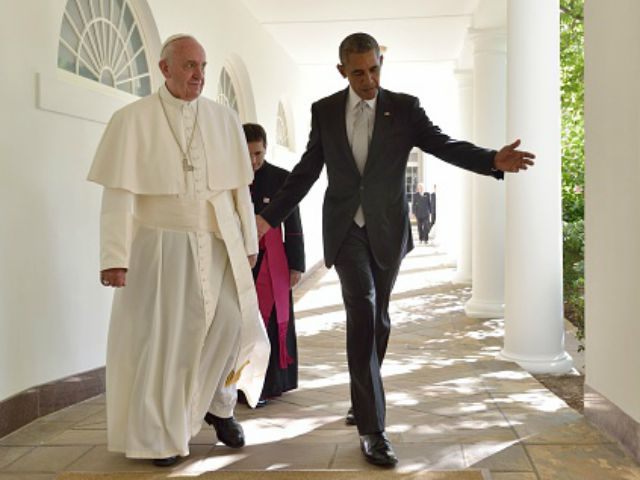During September’s visit by Pope Francis, the White House assisted an effort by homosexual rights activists to embarrass Philadelphia’s Catholic archbishop and to protest the firing of a Pennsylvania Catholic school teacher.
The matter got little attention amid the excitement about the Pope’s visit, but a serious question remains: What purpose does the White House have in interfering with a personnel dispute at a Catholic school?
When Pope Francis visited the White House on September 23, the 15,000 invitees reportedly included several activists looking to score points against the Catholic Church. One of them was Margie Winters, the former religious education director at Waldron Mercy Academy in Merion, Penn., who was specially invited with her same-sex partner at the request of the Human Rights Campaign.
Winters was fired from the Sisters of Mercy school when parents discovered that she was legally married to Andrea Vettori in 2007, and the Archdiocese of Philadelphia publicly supported the school’s action. Agree with the Catholic Church’s teachings or not, it’s not difficult to understand that a Catholic school should expect public adherence to those tenets from its teachers. Without such witness as a component of forming students in the Catholic faith, there’s not much point to a Catholic school.
But in approving the White House invitation for Winters and Vettori and appearing to take sides in a personnel dispute, the Obama administration interfered with the religious freedom of a Catholic school. It seemed to reject the very principles which protect Catholic education in a free society.
Winters and Vettori have been vocal about their objective to persuade Pope Francis “to intervene on our behalf and countless other faithful Catholics so that we may not be condemned to live a life exiled from a church we so love and want to serve.” According to a video made by Vettori prior to the Pope’s visit, she hoped that Philadelphia Archbishop Charles Chaput could be persuaded to back off his public support for the school: “We’re asking the bishop to stop firing people for LGBT issues.”
Their attempt to use the Pope’s visit as an opportunity to protest Winters’ firing was never likely to succeed, because they wanted Church leaders to effectively disavow their own moral beliefs. But it is disturbing that the Obama administration would willingly and symbolically interfere in a serious and difficult personnel dispute that strikes at the heart of religious education in the United States—the faithful witness of its teachers.
This is no small matter. Either Americans figure out how to uphold the First Amendment’s protection for religious education, even when society’s changing norms conflict with religious beliefs, or one of the most fundamental principles of American freedom will be lost—perhaps forever.
Winters and other activists would like to usurp the Pope’s message of inclusion and mercy in support of dismantling the very essence of Catholic education, which is to teach and uphold the Catholic faith. As John Garvey, president of The Catholic University of America, wrote jointly with Washington, D.C., Cardinal Donald Wuerl, “Mercy is not the same as moral relativism. Disagreement is not the same as discrimination. The law goes too far when it demands that the Church abandon its beliefs in the pursuit of an entirely novel state of equality.”
For those who work in any ministry of the Catholic Church, there are protocols and policies to ensure consistency in mission. To be authentically Catholic, a school can’t fudge the teaching of the Church to address the contrary wishes of a special interest group. Catholic teachings govern all aspects of Catholic education, or else it isn’t Catholic. Teachers, parents and students should expect the tenets of the Church to be at the core of the curriculum and employment standards. In secular terms, it is our “brand”—but even more, it’s what defines our schools.
Throughout the history of the United States, respect for religious liberty has ensured the Church its freedom to establish Catholic schools, instruments of the Church to ensure that new generations of students grow in the Catholic faith and become leaders in the society and the Church. Catholic parents rely on Catholic educators to partner with them in the intellectual and moral formation of their children. The principles that are the foundation of an authentic Catholic school are non-negotiable.
Those principles include Catholic teachings about the expectations of Catholic teachers. The Vatican has long taught that faculty behavior must be rooted in Gospel values—a witness that helps prepare students for a life of moral and Christian living. At the core of the Catholic school teacher’s work are pedagogy and curriculum that serve a faith community.
The Pope came to the United States to visit the 70 million Catholics who reside here, but he also speaks for them to the broader society. At the White House, Pope Francis reminded Catholics to build a society that is inclusive by rejecting every form of injustice and discrimination and to be vigilant and defend freedom from anything that would threaten or compromise it.
That was a message to the powers in Washington, D.C. Catholics who value the mission of Catholic education will continue to demand religious freedom so that we can live out our faith—without intimidation or any type of persecution—for generations to come.
Jamie Arthur, Ph.D., is a senior fellow at The Cardinal Newman Society and manages the Catholic Education Honor Roll.

COMMENTS
Please let us know if you're having issues with commenting.